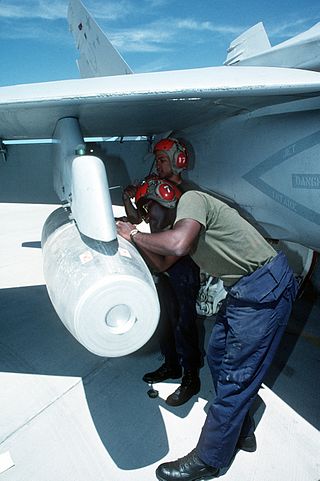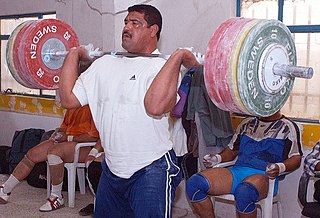
The M47 bomb was a chemical bomb designed during World War II for use by the U.S. Army Air Forces. [1]

The M47 bomb was a chemical bomb designed during World War II for use by the U.S. Army Air Forces. [1]
The bomb was designed for aerial bombardment and maximum efficiency after being dropped. Therefore, the bomb had a very thin metal sheet as its only cover, as little as 1⁄32 inch (0.79 mm). [1] The bomb is approximately 8 inches (200 mm) in diameter, with a nose the shape of a hemisphere. [1] The M107 bomb fuse at the nose of the bomb detonated the weapon, allowing for the release of the contents inside. The bomb was designed to carry either white phosphorus (WP) or a mustard agent (H). [1] However, the H bomb filler was found to leak from the bomb when loaded, and the M47 and its variant M47A1 were not allowed to be loaded. [1] This was due to the thin steel walls on the weapon. In storage and handling, both corrosion and rough handling were found to cause the bomb to leak. [1] When the bomb is loaded with the chemical filler H, it weighed approximately 93 pounds (42 kg), 73 pounds (33 kg) of which are from H. [1]
The M47 bomb could also be used as an incendiary device. [2] [3] A mixture of rubber and gasoline could be used in the field to produce a crude incendiary bomb. [1] A mixture of white phosphorus and jelled gasoline also produced a flammable mixture. [2] Other mixtures included: LA-60 in which crude latex was combined with caustic soda, coconut oil, and water, crepe rubber (CR) in which crude latex reduced to a solid by precipitation and kneading, LA-100 in which crude latex was dried until it was 100% solid, smoked rubber sheets (SR) in which crude latex that has been dried over a fire until it is 100% solid. [1]
When used with these fillers, the bomb used a 1-pound (0.45 kg) black powder charge to ignite and scatter the incendiary materials. [1] The bomb typically weighed about 85 pounds (39 kg) when the incendiary fillers are used. [1]
The M47A1 was designed to replace the M47. It has a thicker steel cover that is about 1⁄16 inch (1.6 mm) thick and an acid resistant corrosion cover inside. [1]
The M47A2 was designed to fix the leaking problems of the M47 when the agent H was carried. [1] On the inside it was coated with a special oil that protected against corrosion from the agent H. [1]

A Molotov cocktail is a hand thrown incendiary weapon constructed from a frangible container filled with flammable substances equipped with a fuse. In use, the fuse attached to the container is lit and the weapon is thrown, shattering on impact. This ignites the flammable substances contained in the bottle and spreads flames as the fuel burns.

Napalm is an incendiary mixture of a gelling agent and a volatile petrochemical. The name is a portmanteau of two of the constituents of the original thickening and gelling agents: coprecipitated aluminium salts of naphthenic acid and palmitic acid. Napalm B is the more modern version of napalm and, although distinctly different in its chemical composition, is often referred to simply as "napalm". A team led by chemist Louis Fieser originally developed napalm for the US Chemical Warfare Service in 1942 in a secret laboratory at Harvard University. Of immediate first interest was its viability as an incendiary device to be used in fire bombing campaigns during World War II; its potential to be coherently projected into a solid stream that would carry for distance resulted in widespread adoption in infantry flamethrowers as well.

ANFO ( AN-foh) (or AN/FO, for ammonium nitrate/fuel oil) is a widely used bulk industrial explosive. It consists of 94% porous prilled ammonium nitrate (NH4NO3) (AN), which acts as the oxidizing agent and absorbent for the fuel, and 6% number 2 fuel oil (FO). The use of ANFO originated in the 1950s.

Incendiary weapons, incendiary devices, incendiary munitions, or incendiary bombs are weapons designed to start fires or destroy sensitive equipment using fire, that use materials such as napalm, thermite, magnesium powder, chlorine trifluoride, or white phosphorus. Though colloquially often known as bombs, they are not explosives but in fact are designed to slow the process of chemical reactions and use ignition rather than detonation to start or maintain the reaction. Napalm, for example, is petroleum especially thickened with certain chemicals into a 'gel' to slow, but not stop, combustion, releasing energy over a longer time than an explosive device. In the case of napalm, the gel adheres to surfaces and resists suppression.

A shell, in a military context, is a projectile whose payload contains an explosive, incendiary, or other chemical filling. Originally it was called a bombshell, but "shell" has come to be unambiguous in a military context. Modern usage sometimes includes large solid kinetic projectiles, which are more properly termed shot. Solid shot may contain a pyrotechnic compound if a tracer or spotting charge is used.

A smoke screen is smoke released to mask the movement or location of military units such as infantry, tanks, aircraft, or ships.

The Mark 77 bomb (MK-77) is a United States 750-pound (340 kg) air-dropped incendiary bomb carrying 110 U.S. gallons of a fuel gel mix which is the direct successor to napalm.
Accelerants are substances that can bond, mix or disturb another substance and cause an increase in the speed of a natural, or artificial chemical process. Accelerants play a major role in chemistry—most chemical reactions can be hastened with an accelerant. Accelerants alter a chemical bond, speed up a chemical process, or bring organisms back to homeostasis. Accelerants are not necessarily catalysts as they may be consumed by the process.

White phosphorus munitions are weapons that use one of the common allotropes of the chemical element phosphorus. White phosphorus is used in smoke, illumination, and incendiary munitions, and is commonly the burning element of tracer ammunition. Other common names for white phosphorus munitions include WP and the slang terms Willie Pete and Willie Peter, which are derived from William Peter, the World War II phonetic alphabet rendering of the letters WP. White phosphorus is pyrophoric ; burns fiercely; and can ignite cloth, fuel, ammunition, and other combustibles.
This article explains terms used for the British Armed Forces' ordnance (weapons) and ammunition. The terms may have slightly different meanings in the military of other countries.
The military of the United States has used many different types of hand grenades since its foundation.

The Pine Bluff Arsenal is a United States Army installation in Jefferson County, Arkansas, about eight miles northwest of Pine Bluff and thirty miles southeast of Little Rock.
The M104 155 mm projectile is a chemical artillery shell designed for use by the U.S. Army. It was specifically designed to carry about 11.7 pounds (5.3 kg) of sulfur mustard (H) or (HD) blister agent. As early as the 1960s, the shell was also filled with white phosphorus to be used for obscuration and signaling.
The M110 155mm Projectile is an artillery shell used by the U.S. Army and U.S. Marine Corps. The M110 was originally designed as a chemical artillery round to deliver blister agents via howitzer as a replacement for the World War I-era 75mm chemical projectiles. The design was later repurposed as a white phosphorus smoke round for marking, signaling, and screening purposes. The white phosphorus variants of the shell also have a secondary, incendiary effect.

A grenade is an explosive weapon typically thrown by hand, but can also refer to a shell shot from the muzzle of a rifle or a grenade launcher. A modern hand grenade generally consists of an explosive charge ("filler"), a detonator mechanism, an internal striker to trigger the detonator, and a safety lever secured by a cotter pin. The user removes the safety pin before throwing, and once the grenade leaves the hand the safety lever gets released, allowing the striker to trigger a primer that ignites a fuze, which burns down to the detonator and explodes the main charge.

The MC-1 bomb was the first U.S. non-clustered air-dropped chemical munition. The 750-pound (340 kg) MC-1 was first produced in 1959 and carried the nerve agent sarin.

The M69 incendiary bomblet was used in air raids on Japan and China during World War II, including the firebombing of Tokyo in 1945. It was created by the Standard Oil Development Company, whose work was funded by the Office of Scientific Research and Development. They were nicknamed "Tokyo calling cards". The M69 was a plain steel pipe with a hexagonal cross section 3 inches (76 mm) in diameter and 20 inches (510 mm) long. It weighed about 6 pounds (2.7 kg).
The Frangible Grenade M1 was a specially designed factory produced molotov cocktail created by the United States in 1942 as it entered World War II (1939–1945). It was designed to provide lightly armed personnel with simple, uncomplicated weapons that were easy to mass-produce. It provided a cheap stopgap means of knocking out enemy vehicles, clearing out strongpoints, and harassing or killing enemy personnel until more effective weapons could be produced and distributed. It was dubbed "frangible" because it was made from glass, which is brittle and easily broken.

A weight plate is a flat, heavy object, usually made of cast iron, that is used in combination with barbells or dumbbells to produce a bar with a desired total weight for the purpose of physical exercise.
The use of incendiary weapons in the Russo-Ukrainian war was first remarked in Sloviansk in June 2014; followed late July 2014 around eastern Ukraine, then in August at Ilovaisk, and between Oleksandrivka and Chumaky in November, all battlegrounds of the war in Donbas (2014–2022).